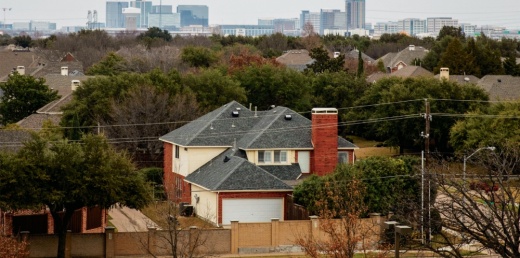The city has been exploring this issue in detail in recent years as the number of residents burdened by their home costs has risen across income groups, Director of Neighborhood Services Lori Schwarz said.
Plano staff members have been researching various options and planning to bring new information before City Council as early as February, she said.
The Neighborhood Services Department investigated the issue in a detailed 2018 housing trends report conducted by Denver-based consulting firm Economic and Planning Systems. The median Plano home price doubled between 2001 and 2017, while the city’s median household income grew by only 33% in that time, according to the report.
“It wasn’t intended to be an affordable housing study,” Schwarz said. “It was intended just to take a broad look at what was going on with our housing market and understand the conditions that our residents were experiencing in relation to the housing market. But one of the things that did come out of that [report] was that housing affordability is an issue regardless of your income.”
In 2016, tens of thousands of Plano households were considered cost-burdened, meaning they spent more than 30% of their income on their mortgages or rent, according to the report. The average cost-burdened household in Plano that year overpaid for housing by $622 per month. In total, the report identified $191 million in overspending annually by cost-burdened Plano households.
While the growth in housing prices has slowed a bit since the report was issued, Schwarz said the city is preparing for a future where affordability remains a concern among Plano residents.
What Plano is doing
While broad trends in the housing and hiring markets drive much of the affordability question, there are areas where the city can step in and make a difference, Schwarz said.
“As of right now, the focus is on maintaining our existing housing stock and helping people [to] be able to stay in their homes, if that is their choice,” Schwarz said.
Plano City Council reinforced this approach in August when it signed off on three priorities for city staff.
Council Member Anthony Ricciardelli said at the time he was concerned that it has become increasingly difficult for young families to find their way into Plano because of the availability of lower-cost homes.
Plano ISD enrollment has declined slightly in recent years, a trend that the district expects to continue in the future.
“It seems to be that when you consider that the median sale price of a home price is higher than the median value, some of the more affordable housing stock in Plano is not on the market,” Ricciardelli said.
As a first order of business, council charged staff with conserving and preserving the affordability of existing housing units through dedicated programs, such as the city’s Great Update Rebate.
The rebate program offers tax breaks for owners of some of the city’s older, more affordable houses if they invest in renovations and improvements to their properties. City officials have found that homeowners participating in this program have seen higher appreciation, making the properties more appealing to sell.
Second, the city is looking for ways to assist the city’s older population with home-safety modifications as some residents continue to age in place.
Finally, the city is looking into various programs to improve the quality of both new and existing housing.
Supply and demand
One factor driving price increases is the relative lack of new home construction in Plano, Schwarz said.
“We are essentially built-out,” Schwarz said. “We have a small amount of land left for residential development. And so we’re dealing [mostly] with existing housing stock.”
On top of the limited land available, the cost of building new homes in the area is rising. Residential building material costs in Collin County ran 56% higher in 2017 than they did in 2001, according to the housing trends report. Single-family construction wages went up 26% in that same time.
More than half of the existing homes in Plano were built at least 25 years ago, which presents its own set of challenges for the market—and for homeowners, Schwarz said.
“Our department [Neighborhood Services] was actually created five years ago to address the needs of neighborhoods and just the maturing community as a whole,” Schwarz said. “We have been working very diligently to support the property owners in making sure that they have safe, healthy housing and safe, healthy neighborhoods.”
Even when a home is listed in a relatively affordable range, it can sometimes be hard for families to win the bidding war, said Cassandra Stahl, a Realtor for Olive Tree Real Estate Group.
Stahl said a number of buyers in the area are not families, but investors. Because investors can often afford to put more down on a home, their offers can be an attractive to sellers, she said.
In addition to assisting residents with repairs and renovations to older properties, the city has a number of other programs for residents burdened by high housing costs.
Plano helps administer state funding to its homeless residents through the Rapid Rehousing Program, which provides them with temporary rental assistance and other support services.
A changing business landscape
The price of housing is also affecting the Plano business community, members of which tend to see affordability as a key factor in recruitment and hiring, Plano Chamber President Kelle Marsalis said.
“Talent and affordability are among the ... top concerns that we hear from the business community,” Marsalis said. “It’s definitely something that is on our radar, and it’s something that’s on the business community’s radar.”
More than four in five Plano jobs in 2016 were held by people commuting in from out of town, according to the housing trends report. The share of in-commuters—as opposed to Plano residents—that make up the city’s workforce is likely to grow in the future, the report concluded.
This could make it harder for some Plano neighborhoods to maintain an engaged group of residents, Schwarz said. The more invested residents are in the various aspects of city life, the more engaged they are likely to be, she said.
“Our goal in this would be that if people wanted to live in Plano, they would have an opportunity to live here,” Schwarz said. “That hits on a variety of topics within the study, and it is going to be up to council to figure out, ‘What does that look like?’”
Plano businesses view the proximity of housing as a big plus in the hiring process, Marsalis said.
“I think, really, from the business community’s perspective, it does go back to the vibrancy of the community and the talent that’s available,” Marsalis said.





